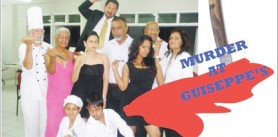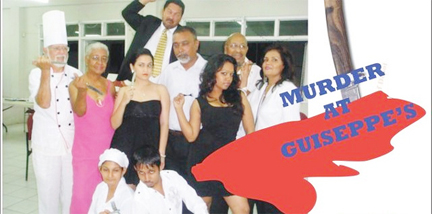Dramatic and other theatrical productions in Guyana have always had little intermittent ‘seasons’ during which there is a varied menu of different offerings in between long periods of inactivity. The variety has rarely been sufficiently wide or judiciously selected to satisfy all tastes or provide a suitably nutritious blend of alternative types. Most often the diet is of presentations that can be popular with ingredients that may supply the audience with generous servings of laughter. There is usually, also, a range in the quality of these with too many that are not sufficiently well prepared.
The middle months of 2009 have been one of the more active ‘seasons.’ There has been a steady flow of productions of one type or another and this increased pace might well be a result of the return of the Theatre Guild Playhouse to active service. Its resuscitation a little over a year ago has made a significant addition to available theatre space and it has so far not been idle for long. Most of the main courses, however, have, as has been the norm, been served up at the National Cultural Centre, long known as the popular venue.
One of the recent entrees on the Cultural Centre menu was one of the different types, a play called Murder at Giuseppe’s staged by The Rotary Club of Georgetown as a fund-raising effort, directed by Gem Madhoo-Nascimento. According to the Programme Notes it was a kind of re-make and adaptation of a play recently staged in India titled Murder on the Menu. The Guyanese version is attributed to three authors, Pradeep Samtani, Satiesh (Chico) Persaud and Gem Madhoo-Nascimento developed from a concept by Pradeep Samtani. Since, according to the Notes, it was Samtani who saw the original in India, one can reasonable accept that the ‘concept’ was really a rehash of Murder on the Menu. In fact, the director continues in her Notes: “He came back very excited and decided that the club will stage (it) and feels that it will be a hit.”

Madhoo-Nascimento’s very important description of the play was “this is meant to be a fun evening and we hope that you the audience will see it that way and have an entertaining evening. It’s a great way to [do] fund-raising but a lot of work and dedication which many have just discovered.” It was therefore very much an amateur effort, never mind the seasoned professionals who were involved, and it is difficult to take it seriously or measure it by the yardsticks of serious production.
Murder at Giuseppe’s was therefore a rehash of Murder on the Menu set in Guyana with several local ingredients, a mixed cast including members of the Rotary Club and others, some of whom had never been on stage before. It was also a mixture of dramatic types based on a murder that took place in a restaurant in the presence of a medley of diners, cooks and waitresses. The result was an interesting, if not very successful, cook-up.
Jay, apparently meant to be an Italian, played by Derek Gomes, runs a restaurant in Georgetown, on premises leased from Tony (Nasim Hussain), a rich playboy goldminer who is apparently in the habit of threatening Jay with cessation of the lease. Tony turns up to dine with his latest girlfriend Sonia (Preya Singh), coincidentally on the same night on which his estranged wife Jess played by Dimple Mendonca, is there with her scheming, overbearing mother (Derry Harry) to drown her sorrow in drink and food while plotting her impending divorce from Tony and her vengeance over him.
There are several others present while the restaurant carries on its busy affairs for the evening. In the middle of it all, Tony drops dead, poisoned by person or persons unknown. The play sets out to be a whodunit after the order of Agatha Christie. Although the foul deed is committed right before our eyes, no one has a clue as to who did it, despite several hints dropped by the playwright here and there, until the dramatic revelation at the end. There is an assortment of characters who all become suspects because everyone has a motive and an opportunity, a good reason to want the victim dead and ample time and occasion to fulfil their desire.
The plot provides a few of the usual convincing suspects. Jay, the restaurateur, might have bumped him off because of increasing fears that he was about to lose his lease. Since “hell hath no fury…” Tony’s estranged wife could have been understandably moved to murder at the sight of him turning up with his brazen mistress. Besides, she is determined to get every penny of his money, if not through a divorce settlement, then through inheritance. Her mother is the chief provocateur in
setting her up to her schemes, so she, too, is quite capable of carrying out the execution herself.
Tony does not seem to make himself likeable, and also succeeds in insulting or hurting the feelings of the waitress Carol (Shameeza Husain) and the cook (Kit Nascimento). And, of course, those two are in the best position by far to make the appropriate alterations to the recipe of his meal.
The play is therefore constructed to provide several likely suspects, and ends up with characters who seem to be there for no other purpose but to add to this list. Some of them play no meaningful part in the plot and appear by way of Deus ex machina. In addition, even some of the more convincing suspects really had no credible opportunity to dump poison in the victim’s food. Occasionally someone would oddly get up and disappear into the kitchen or slip off-stage to return later for no apparent reason.
The dramatic fabric was therefore flimsy. Anthony (Hashim Alli), a secret son of Tony’s, suddenly turns up to be insulted by his father with whom he has a violent quarrel ending in threats. A doctor is present who is continuously pushed around and is never served, thus forced to issue repeated threats “wait till I get you in my surgery” (or words to that effect). He has nothing else to do. He was played by Laurie Lewis, one of the “senior Rotarians” better known for solving murders in his other life. Perhaps he was given that role with little to do and nothing to say for fear he would not remember his lines, but Former Police Commissioner Lewis has carried the ‘false-name’ Trinculo all his adult life and obviously the director did not know how he got it. History has it that he was quite an actor as a student at Queen’s College and starred so famously in the role of Trinculo in one of Shakespeare’s plays that the name stuck, never to be removed.
Then there was a Stabroek News reporter (Bernadette Yassin) who was mysteriously there snapping pictures of everything. Since it is not the Stabroek, but another of its competitors who is notorious for being at the scene of every crime, this character had no dramatic purpose in the play and no motive or opportunity for murder.
Apart from meaning to be a whodunnit, the play also wished to be hilarious, and therefore threw in some laughs including touches of farce, such as a cat fight between Jess and Sonia, the antics of Nascimento as the cook and a singing menu performed by Gomes. That was another element in the production, since something of the musical and the carbaret were also introduced. But while Jay’s solo was meant to be funny, the presence of Oliver Michael Bailey as house musician seemed to have had serious intentions. It did not quite work. However, that was not all, since there were also a number of topical social and political references, innocuous stuff that brought a laugh, so justified their inclusion.
That was the nature of Murder at Guiseppe’s. It was not the kind of production that one can take seriously, nor was it meant to be. Most faults can therefore be forgiven, except for one at the end. They ought to have kept Rotary President Mr Samtani as far as possible from the microphone. When you subject your audience to those superfluous portions of insensitive, lengthy and tedious talk and ceremony, the risk is indigestion. He well nigh cancelled out the generous servings of goodwill with which the play was received.






